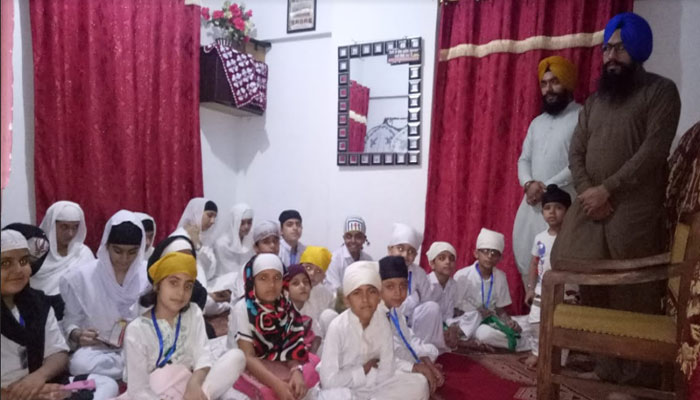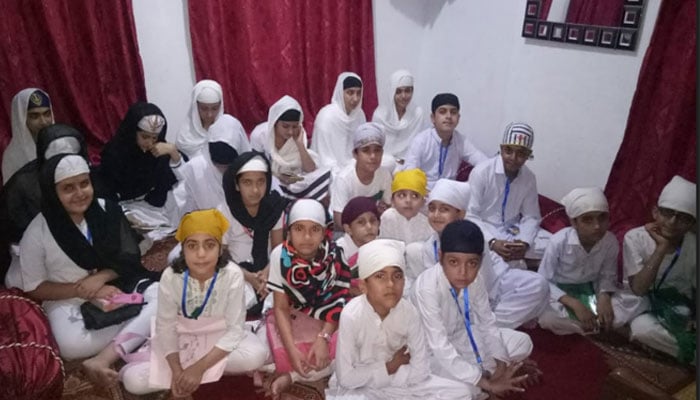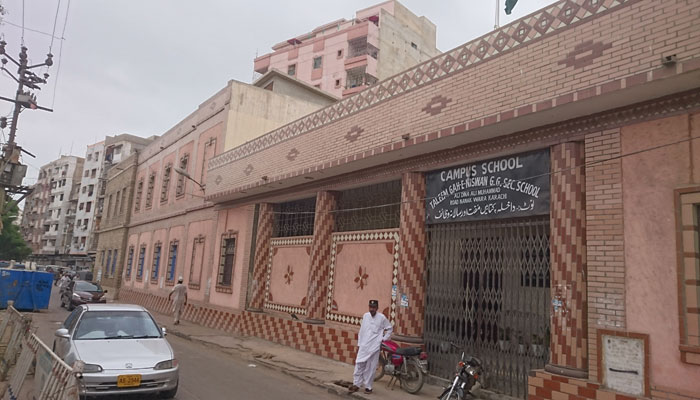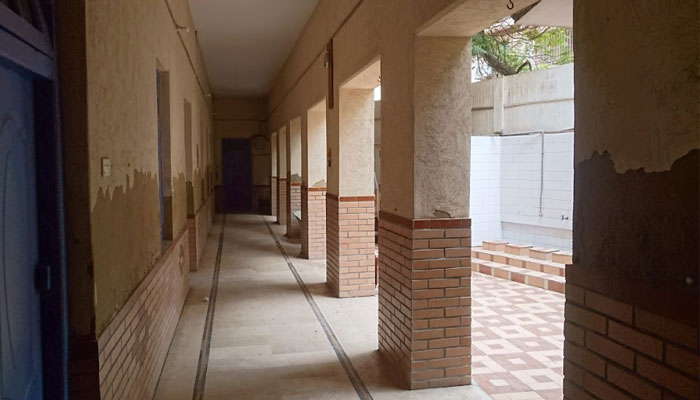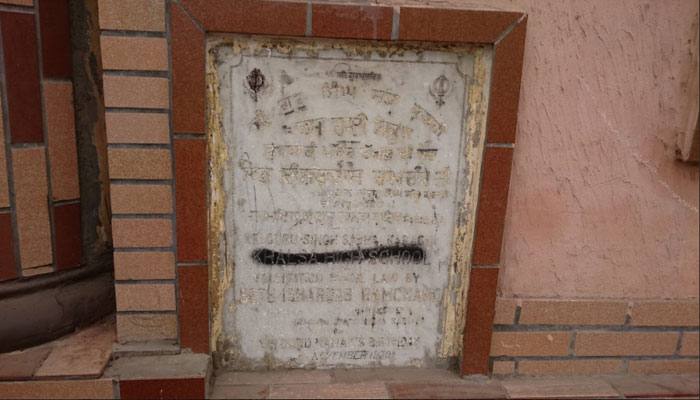Sikh religion, culture and history surviving through informal schools
Twenty-two boys and girls aged between seven and 14 are packed together in the tiny classroom of an informal school located on the sixth floor of a residential building on MA Jinnah Road.
Twenty-two boys and girls aged between seven and 14 are packed together in the tiny classroom of an informal school located on the sixth floor of a residential building on MA Jinnah Road.
Their teacher Taranjeet Singh wears a Dastaar (turban), while their heads are covered with white and yellow Rumaal as they listen to the recitation of the Sikh scripture Guru Granth Sahib by one of their classmates. Every evening these children gather here from various blocks of Naz Plaza to study the Gurmukhi script and Sikhism.
Named Guru Nanak Dev Jee Khalsa Darmik School Karachi, the school was started in 2013 by Taranjeet and his elder brother Jagmohan Singh for Sikhs and Nanakpanthis (admirers of the teachings of Sikhism founder Guru Nanak) in a room of their rented flat.
“We arrange classes after work from 9pm to 10:30pm,” said Jagmohan. “It is mandatory for Sikh students to get education according to the Sikh Rehat Maryada, a guideline for Sikhism.”
The guideline was approved in 1945 by Amritsar-based Shiromani Gurdwara Parbandhak Committee (SGPC), an international body that manages Sikh worship places, particularly in the Indo-Pak region. However, Nanakpanthi Hindu students also join Sikh boys and girl at the school to learn about the Sikh religion, culture and history.
After insurgency in the then Khyber Agency, the terrorist Tehreek-e-Taliban Pakistan had threatened minorities to leave the area unless they paid Jizya, a per capita yearly tax historically levied on non-Muslims permanently residing in Muslim lands.
“When we moved to Karachi, we could not find a school where our children could learn about Sikhism,” said Jagmohan. “We then decided to start a school in our home to educate our own children as well as other students.”
The students
Thirteen-year-old Shiv Kumar, a student at a private school, said his institution teaches minority students ethics and the Bible. After school a teacher tutors him at home, so he is left with only a little free time.
“After that I do my assigned homework and then prepare to attend Sikhism classes in the evening,” he said. Kumar hardly gets any time for games, but he is happy with his busy schedule.
Shivani Kumari, 11, said her teachers at school do not arrange classes for Sikhism, adding that she wished to know about the religion that her parents practice.
“It is not difficult for me to juggle school, home tutoring and Sikhism classes because learning about Sikhism is a holy activity,” she said. Her family reads the scripture daily, and they wanted her to study Gurmukhi and Sikhism along with her school subjects.
Holding on
Due to a dearth of teachers at public schools, Sikhs and other minorities have to study Islamiat. “We have no objection, of course, because Sikhs strongly believe in inter-faith harmony,” said Taranjeet. “But we don’t want to forget about our own religion, culture and history.”
He said they wanted to set up a proper school in Karachi to provide modern education along with religious education, but they could not find space. Some community members, however, arrange classes at their own homes and at Sikh temples.
Sikhs in other parts of the country have set up their own private schools, mostly in Khyber Pakhtunkhwa capital Peshawar and northern Punjab city Hasanabdal, where Sikh children can get education in accordance with Sikhism.
Khalsa High School
Before Partition, Karachi’s Sikhs had set up a similar school in one of the busiest localities of the city. Situated at the back of the city courts, the Khalsa High School’s pink building is still standing.
Built by Sikhs in 1930 on Ali Dina Ali Muhammad Road, Nanak Wara, Saddar Town, it was the only educational institution of the city’s Sikh community.
According to the commemorative plaque fixed next to the school’s entrance, the institution’s foundation stone was laid by Seth Ishwardas Ramchand, former president of Sri Guru Singh Sabha, Karachi, on Sri Guru Nanak’s birthday: November 16, 1930. The school was the property of Sri Guru Singh Sabha functioning under the SGPC.
Forgotten history
“There is no preserved history about the Khalsa High School apart from the inaugural plaque,” said Najma Ayub, who has been teaching at the institution since 1996.
“One of my mentors, Miss Parveen Fatima, who got her education from the Khalsa High School and taught here until she retired, said Miss Fatima Jinnah had adopted the institution when Pakistan came into being.”
Najma said Miss Jinnah initially set up a vocational training centre for women on the school’s premises. After she passed away, however, the authorities turned the centre into an educational institution.
“Around 22 years ago, when I joined the school as a teacher, I had seen some sewing machines here,” she said. Perhaps Miss Jinnah had renamed the school to Taleem Gah-e-Niswan, which later became a public secondary school for girls. Last year the Karachi Bar Association had adopted the institution.
Sikh properties
In 1960 Pakistan established the Evacuee Trust Property Board (ETPB) and tasked it with managing evacuee properties attached to religious, charitable or educational trusts left behind by Hindus and Sikhs who had migrated to India after Partition.
The ETPB had agreed that evacuee properties would neither be sold nor their original form be changed. “Later, Gen Ziaul Haq allotted some Sikh and Hindu properties, including the Khalsa High School, to the education department,” said Pakistan Sikh Council chief Ramesh Singh. After the 18th amendment, the institution is now under the school education department’s control.
Lost symbols
Before Partition, Karachi’s old city area was populated by Hindus, Sikhs, Christians, Muslims and Parsis. “Each of these communities had established their own schools,” said Ramesh.
Except for some well-known institutions, most of the others have disappeared from the city’s historical landscape. Declared abandoned properties, some of them were either occupied or demolished. “The authorities have never valued such heritage sites except fix small plaques declaring them heritage sites.”
While the government has handed over some of the abandoned properties to the Christian, Hindu and Parsi communities, the Sikhs of Karachi remain deprived of their properties.
Lukewarm response
In 2004, when Hamida Khuhro was appointed Sindh education minister for a second term, the Sikh community had requested her to return to them the Khalsa High School and the Ratan Talao Gurdwara situated on the premises of the Government Ziauddin Memorial Nabi Bagh College on Saddar Town’s Preedy Street.
“She had acknowledged that these properties belong to Sikhs and that they need it, but no concrete measures were taken for returning them to us,” said Ramesh. “The Khalsa High School is the only heritage of education of Karachi’s Sikh community.”
Going it alone
When the Singh brothers had started the school, a number of Sikh families contacted them to enrol their children, but they had to refuse because their little flat is not sufficient for running a proper school. Over 25 students are enrolled right now, while 15 have already graduated.
Some gurus and community members in other parts of the city also run similar schools without any help from the government.
With the Khalsa High School yet to be handed over to Sikhs, the community has no space in the city to educate their children according to their religion.
-
 Spencer Pratt Recalls Meeting Ryan Gosling Before Fame
Spencer Pratt Recalls Meeting Ryan Gosling Before Fame -
 Meghan Markle's As Ever Facing Branding Problems?
Meghan Markle's As Ever Facing Branding Problems? -
 Kate Middleton Is More Relaxed In 'Wellington Boots Than Diamond Tiara'
Kate Middleton Is More Relaxed In 'Wellington Boots Than Diamond Tiara' -
 Gaten Matarazzo Addresses Important Fans Query About 'Stranger Things'
Gaten Matarazzo Addresses Important Fans Query About 'Stranger Things' -
 Prince William's Latest Move Reveals Rift Is Strong With Prince Harry
Prince William's Latest Move Reveals Rift Is Strong With Prince Harry -
 Princess Eugenie Becomes Second Royal After Meghan To Feature In Viral Trend
Princess Eugenie Becomes Second Royal After Meghan To Feature In Viral Trend -
 Carol Burnett Sings Praises Of Late Jimmy Stewart: 'He Had THIS'
Carol Burnett Sings Praises Of Late Jimmy Stewart: 'He Had THIS' -
 Kate Middleton Dashes Through Rain At Windsor Castle
Kate Middleton Dashes Through Rain At Windsor Castle -
 Dave Filoni, Who Oversaw Pedro Pascal's 'The Mandalorian' Named President Of 'Star Wars' Studio Lucasfilm
Dave Filoni, Who Oversaw Pedro Pascal's 'The Mandalorian' Named President Of 'Star Wars' Studio Lucasfilm -
 Is Sean Penn Dating A Guy?
Is Sean Penn Dating A Guy? -
 Sebastian Stan's Godmother Gives Him New Title
Sebastian Stan's Godmother Gives Him New Title -
 Alison Arngrim Reflects On 'Little House On The Prairie' Audition For THIS Reason
Alison Arngrim Reflects On 'Little House On The Prairie' Audition For THIS Reason -
 Spencer Pratt Reflects On Rare Bond With Meryl Streep's Daughter
Spencer Pratt Reflects On Rare Bond With Meryl Streep's Daughter -
 'Stranger Things' Star Gaten Matarazzo Recalls Uncomfortable Situation
'Stranger Things' Star Gaten Matarazzo Recalls Uncomfortable Situation -
 Gaten Matarazzo On Unbreakable Bonds Of 'Stranger Things'
Gaten Matarazzo On Unbreakable Bonds Of 'Stranger Things' -
 Beyonce, Jay-Z's Daughter Blue Ivy Carter's Massive Fortune Taking Shape At 14?
Beyonce, Jay-Z's Daughter Blue Ivy Carter's Massive Fortune Taking Shape At 14?
